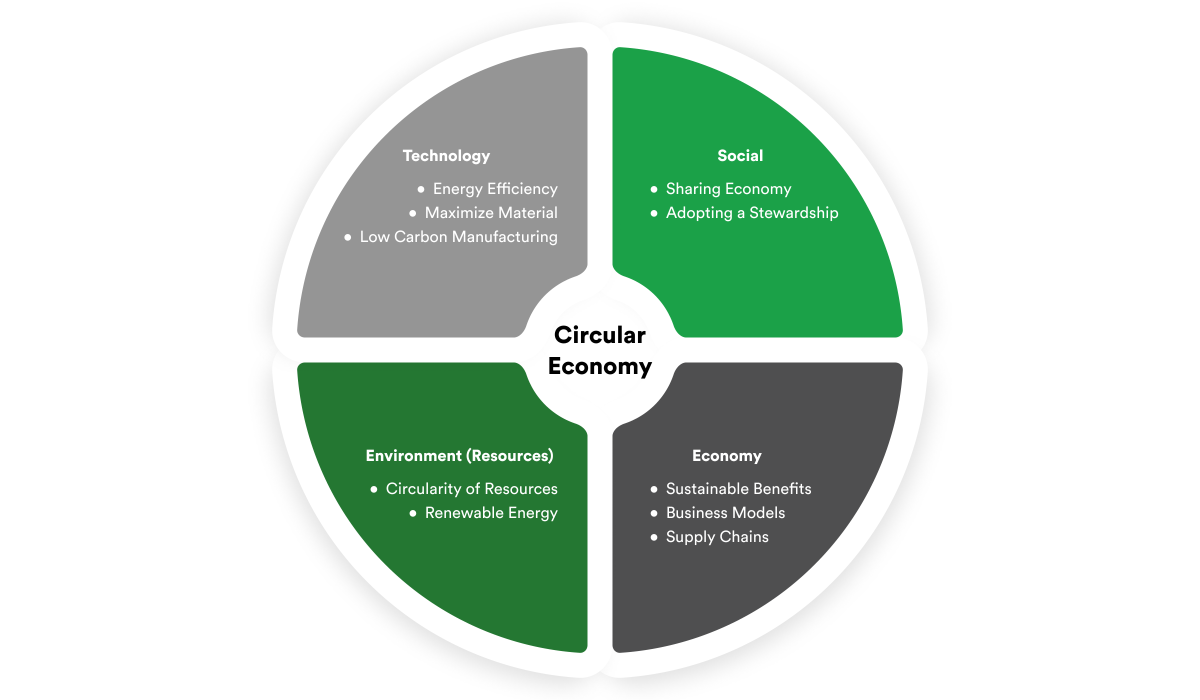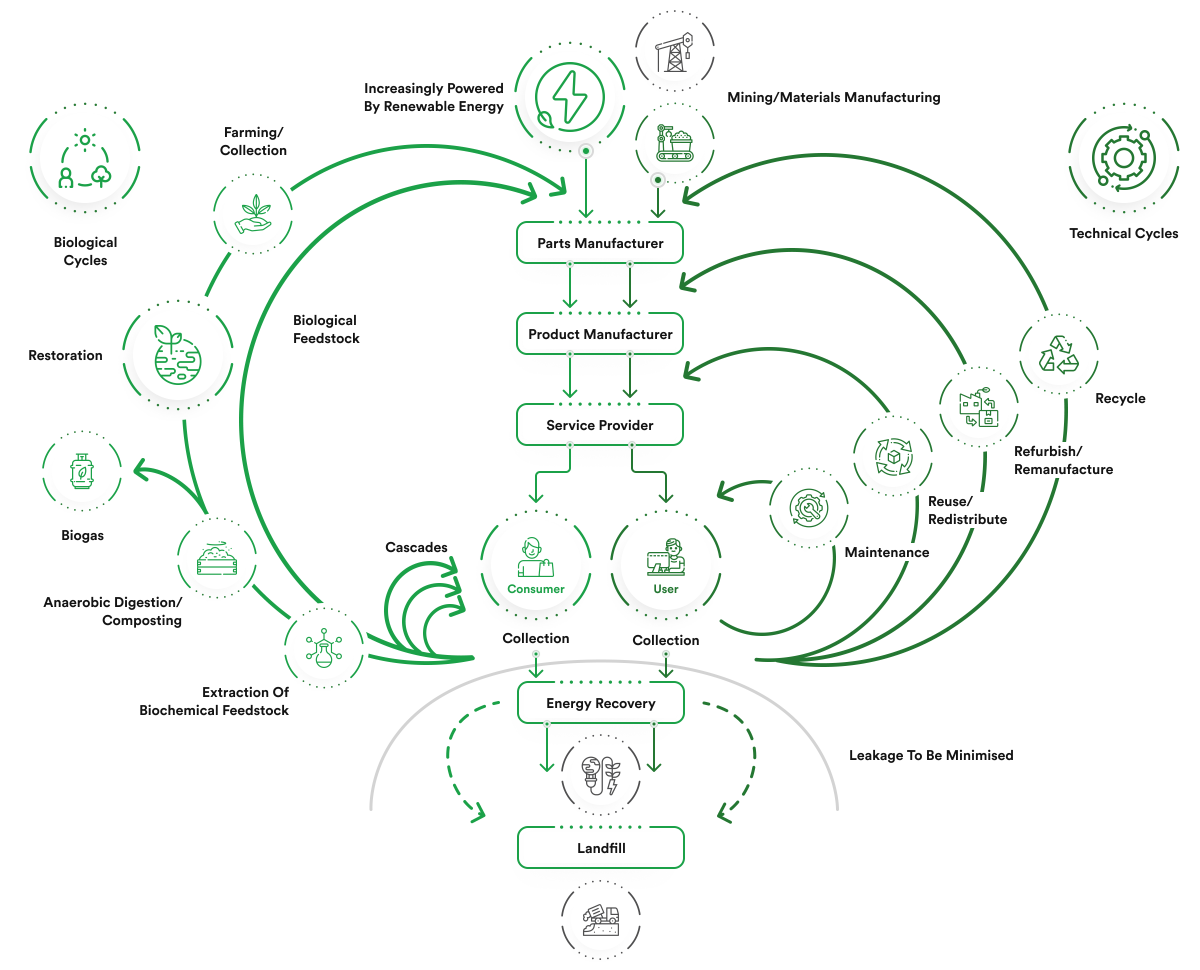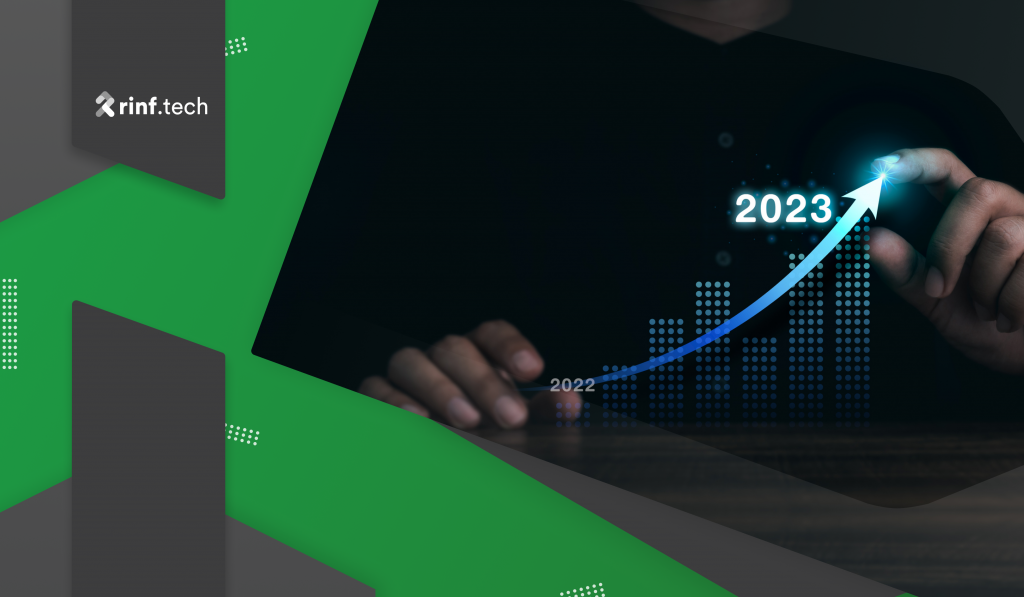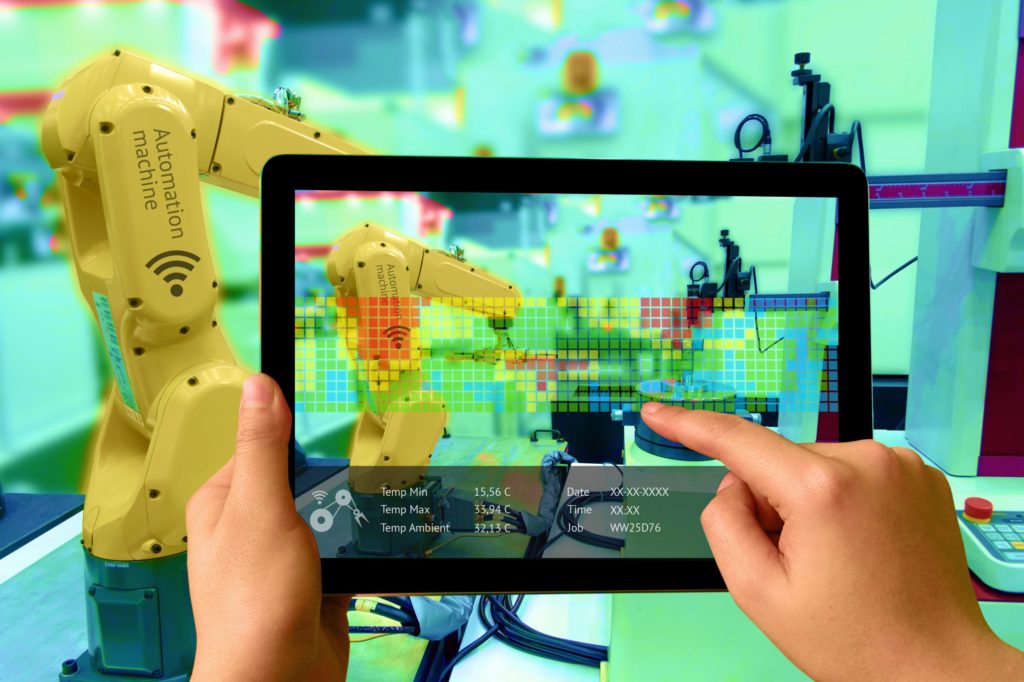
2024 Technology Trends Across Industries and Verticals
Exploring 2024’s primary technology trends through the lenses of the world’s most vibrant and essential industries.
This is a significant departure from the traditional linear economy, which has resulted in alarming levels of environmental damage. Adopting a circular approach is more than just being sustainable. It’s about building a resilient economy that can handle future challenges. A recent study found that moving to a circular economy could bring $4.5 trillion in economic benefits by 2030.
In a time when environmental issues are urgent, the idea of a circular economy stands out as a promising alternative to the old “take-make-dispose” model. This outdated approach has pushed us towards resource exhaustion, uncontrollable waste, and a climate crisis that endangers our planet’s health. The circular economy offers a restorative model that aims to minimize waste and reuse resources, creating a sustainable cycle that benefits both the economy and the environment.
This article explores technology’s crucial role in creating this sustainable, innovative future.
In the transformative move towards a circular economy, technology plays a crucial role as a catalyst, connecting forward-thinking environmental ideas with practical, real-world uses.
The rise of blockchain technology has opened the door for secure, transparent digital product passports. These passports act as an extensive digital record, showing a product’s materials, its entire lifecycle, and who has owned it. This advancement in technology offers numerous benefits. For instance, it improves how easily products can be tracked, making them more straightforward to reuse, repair, and recycle.
A Gartner report suggests blockchain technology in supply chain management could create $3.1 trillion in new business value by 2030.
Digital product passports are more than just monitoring products. They change how consumers interact and take responsibility. With access to detailed information, consumers can make better choices about what they buy, how they maintain it, and how they dispose of it, leading to more sustainable consumption habits. The European Commission has seen the value of this technology, proposing to include it in the EU’s Circular Economy Action Plan.
Artificial Intelligence is transforming product design, focusing on ease of disassembly and recovery of components. AI algorithms create modular products made with standardized materials designed for long-term use. This new approach to design is vital for sustainability, ensuring products can be easily broken down and their parts reused or recycled. A study by Accenture indicates that AI’s role in circular economy initiatives could contribute to a $4.5 trillion increase in global economic growth by 2030.
Beyond just disassembly, AI is essential in prolonging the life of products. AI can suggest design improvements to make products last longer by analyzing how products are used and identifying stress areas. This proactive design strategy reduces waste and enhances economic efficiency by maximizing each product’s lifespan.
Traditional sorting methods struggle with the complexity of modern waste, but robotic sorting systems with AI-powered vision are changing this. These systems can accurately identify and separate different materials, making recycling more efficient.
Using AI and robotics in waste management also has significant environmental benefits. These technologies make sorting more precise and efficient, reducing the need for landfills and incineration and thus decreasing greenhouse gas emissions. The United Nations Environment Programme emphasizes technology’s role in meeting Sustainable Development Goals, especially in responsible consumption and production.
The emergence of online platforms for remanufacturing and upcycling demonstrates technology’s role in promoting circular economy efforts. These platforms use AI to connect products with remanufacturing partners, handle transactions, and track products’ circular journeys. Several businesses have started using blockchain technology to increase transparency in their supply chains. In 2019, Ford began experimenting with blockchain tracking solutions to confirm that the cobalt used in its electric vehicles is sourced ethically.
These platforms also educate about remanufacturing and upcycling, connecting conscious consumers with sustainable practices. They show how technology can make the circular economy a practical reality. The Global Recycling Foundation notes the growing impact of digital platforms in encouraging recycling and upcycling.
Gamification methods like points, badges, and rewards effectively encourage consumers towards circular practices. These interactive techniques make responsible consumption and resource conservation more engaging, setting a new standard in environmental responsibility. Gamification is also used in corporate settings to promote sustainability through employee engagement and rewards. This approach builds a sustainability-focused culture and contributes to broader corporate social responsibility efforts.

The role of technology in fostering a circular economy goes much further than what’s immediately apparent. New technologies are reshaping sustainable practices with innovative and efficient solutions.
Blockchain is changing how we view sustainable marketplaces. These decentralized platforms provide unmatched transparency and security, making trading recycled materials and sustainably made goods easier. They ensure that every step from production to sale is traceable, giving consumers confidence in the sustainability of their purchases. Gartner predicts that by 2024, 20% of large enterprises will use digital currencies in blockchain-based marketplaces for payments, rewards, or assets.
Artificial Intelligence is vital in prolonging product lifespans. AI-powered repair guides offer detailed, customized instructions, making repairs more approachable and promoting a maintenance-over-disposal mindset. The potential of AI-driven repair guides extends into predictive maintenance, fundamentally altering how we manage product lifespans. By analyzing usage data and wear patterns, these intelligent systems can forecast potential failures and suggest preemptive maintenance, effectively preventing breakdowns before they occur.
3D printing is revolutionizing the production of spare parts. It allows manufacturers and consumers to print parts on demand, significantly reducing inventory needs and waste. This technology also supports repairing and refurbishing older products, especially those with parts no longer in production. The versatility of 3D printing in producing spare parts opens up new possibilities for customizing and enhancing existing products. This flexibility helps extend the utility and lifespan of products, aligning perfectly with the principles of a circular economy. 3D printing promotes a more sustainable and efficient manufacturing approach by facilitating the creation of parts tailored to meet unique requirements. It reduces the need for mass-producing spare parts, lowering the environmental impact of overproduction and surplus inventory.
Tools for supply chain transparency, often powered by blockchain and IoT, are crucial for verifying product authenticity and sustainability. They enable the tracking of materials and products through the supply chain, upholding ethical and environmental standards. These transparency tools are crucial in promoting responsible sourcing and ethical manufacturing practices. By offering a clear view of the supply chain, companies can spot and tackle potential issues related to labor rights, environmental impact, and ethical sourcing. This transparency improves a brand’s reputation and allows consumers to make choices that align with their values.
The Internet of Things is increasingly used for more effective resource management. IoT sensors monitor resource use in real time, producing more efficient material and energy. This is particularly impactful in agriculture and manufacturing. The widespread use of the Internet of Things in resource management is about more than just efficiency; it marks the beginning of a new era in precise and sustainable resource use. By embedding IoT sensors at different points in the production process, businesses can get detailed insights into how materials are used, energy is consumed, and waste is generated. This instant data allows companies to make well-informed decisions, fine-tune their processes, and significantly reduce their environmental impact.

Collaborative efforts and complex challenges mark the journey towards a circular economy. An integrated approach is required, bringing together the strengths of different sectors and stakeholders.
The success of a circular economy relies heavily on collaboration across various sectors. This includes partnerships among technology companies, manufacturers, policymakers, and consumers. Each group contributes uniquely:
The World Business Council for Sustainable Development (WBCSD) stresses the importance of collaborative innovation in circularity, suggesting that cross-sector partnerships could speed up the transition by up to 50%.
A significant hurdle in circular economy implementation is more standardization and regulation. Consistent standards are necessary to ensure that materials and products are designed and managed to support circularity. Governments and international bodies play a vital role in setting these standards and regulations. The European Union’s Circular Economy Action Plan is an example, with ambitious waste reduction and recycling goals.
Infrastructure Development
Another significant challenge is developing the proper infrastructure, including recycling facilities, remanufacturing centers, and digital platforms for circular goods. These developments require substantial investment and coordination. Developing infrastructure is fundamental to realizing a circular economy. This infrastructure is the backbone for circular activities, enabling material collection, processing, and redistribution. For instance, advanced recycling facilities with modern technologies can significantly enhance material recovery rates. Digital platforms are also vital in this system, offering the necessary connection and transparency for tracking materials and products.
Data privacy and security concerns arise as digital technologies become essential in circular economy strategies. Technologies like IoT, blockchain, and AI involve handling vast data amounts, raising privacy and protection issues. Compliance with regulations like GDPR is critical for companies in this area. KPMG’s survey shows that data privacy is a top concern for 70% of technology leaders adopting new technologies.
Adapting to technological changes within the framework of a circular economy goes beyond just keeping up. It’s about adopting a culture of ongoing innovation and adaptability. As new technologies emerge and evolve, they open fresh opportunities for sustainable practices and innovative business models. For businesses, this entails maintaining agility and being receptive to incorporating new technologies into their operations. Such integration can increase efficiency, cost savings, and environmental benefits.
Policymakers, however, are tasked with devising regulations supporting technological advancements while safeguarding environmental and consumer interests. This dynamic setting calls for a culture of continuous learning and a readiness to experiment and refine approaches. It’s about fostering ecosystems where businesses, academic institutions, and governments can collaborate, exchange ideas, and jointly develop solutions that adhere to the principles of circularity. Successfully navigating these technological shifts is crucial for establishing a resilient and sustainable economy capable of enduring and flourishing amidst future challenges.
The transition to a circular economy, powered by innovative technologies, presents a transformative solution to the pressing environmental challenges of our time. This new economic model, which pivots away from the traditional linear “take-make-dispose” approach, offers a sustainable and efficient system where materials are reused, waste is minimized, and resources are conserved.
The emergence of digital product passports, AI-powered design for disassembly, automated sorting, and advanced manufacturing technologies like 3D printing, are not just innovative developments; they are essential components in building a circular economy. These technologies enable more efficient resource management, enhance product lifespans, and promote sustainable consumption and production patterns. The incorporation of blockchain and IoT in supply chain transparency and resource management further underscores the role of digital innovation in achieving circularity.
However, the shift to a circular economy is not without its challenges. It requires a holistic approach, involving cross-sector collaboration, standardization, and regulatory support. The development of a robust infrastructure, addressing data privacy and security concerns, and adapting to rapid technological changes are crucial steps in this transition. Policymakers, manufacturers, technology companies, and consumers must all play their part in this collaborative effort.
As we look towards the future, it is evident that embracing a circular economy is more than an environmental imperative; it is an economic and social opportunity that holds the potential for significant benefits. By leveraging technological advancements and fostering a culture of sustainability and innovation, we can build a more resilient and prosperous future, ensuring a healthier planet for generations to come.

Exploring 2024’s primary technology trends through the lenses of the world’s most vibrant and essential industries.

This article recaps the findings of the recent McKinsey Report on the 4 tech trends reshaping the future business landscape.

The evolution of industrial production. How IoT and Robotics will be the main characters in the story